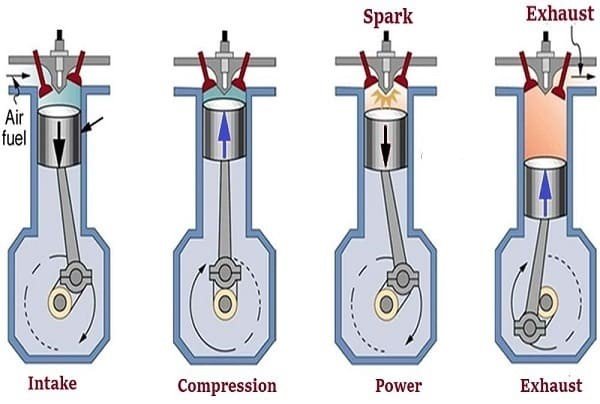What is 4 Stroke Engine?
A 4-stroke engine is an IC engine that uses four strokes of the piston to complete a working cycle. It converts the thermal energy of the fuel into useful mechanical work due to the upward and downward movement of the piston. Therefore, it belongs to the category of the reciprocating engine.
A four-stroke engine completes a power cycle after the completion of two revolutions of the crankshaft and 4 strokes of the piston. These engines are most widely used in different vehicles such as light trucks, buses, vans, cars, etc.
In this reciprocating engine, the compression process occurs due to the up and down movement of the piston.
The main difference between the 2-stroke and 4-stroke engines is that a 2-stroke engine completes a working cycle in just two strokes while a four-stroke engine completes a working cycle in four strokes of the piston. A 2-stroke engine produces less pollution compared to a 2-stroke engine.

How does a 4-Stroke Engine work?
A four-stroke engine works in the following steps:
Intake stroke
- As the piston reciprocates toward BCD from TDC (downward), a vacuum starts producing inside the compression chamber (cylinder).
- When the vacuum produces inside the compression chamber, the exhaust valve closes, and the inlet valve opens.
- When the inlet valve opens, the air-fuel mixture starts entering the compression chamber.
Compression stroke
- As the internal pressure of the compression chamber becomes equal to the outer pressure, the inlet valve closes, and compression stroke starts.
- As the piston moves upward (from BCD to TDC), it compresses the air-fuel mixture inside the compression chamber and increases the temperature and pressure of the air-fuel mixture.
Power stroke
- The power stroke is also known as a combustion stroke.
- When the compression stroke is nearly to be complete, a spark plug burns the compressed air-fuel mixture.
- As the fuel gets ignited, the power is generated so that the piston moves from TDC to BDC by expanding the chemical reaction. Therefore, this stroke is called POWER STROKE.
- Due to this burning process, the temperature and pressure of the mixture become very high. Due to an increase in pressure, the air-fuel mixture pushes the piston to move downward (toward BCD from TDC) and drives the crankshaft, which further moves the vehicle.
- During this process, both the inlet and exhaust valves remain shut.
Exhaust stroke
- After the completion of the power stroke, the exhaust stroke starts.
- In the exhaust stroke, the piston again moves upward (from BDC to TDC).
- During this stroke, the inlet valve closes, and the exhaust valve opens. The piston pushes the exhaust gases out of the combustion chamber.
- After completing the exhaust stroke, the piston again moves downward (from TDC to BDC), sucks air-fuel mixture and the whole cycle repeats. This final stroke forces the spent gasses/exhaust out of the cylinder.

